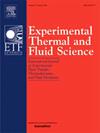Study on the formation and characteristics of CH4/H2 non-premixed lifted jet flames
IF 3.3
2区 工程技术
Q2 ENGINEERING, MECHANICAL
Experimental Thermal and Fluid Science
Pub Date : 2025-07-11
DOI:10.1016/j.expthermflusci.2025.111561
引用次数: 0
Abstract
Adding hydrogen to natural gas is a promising way to transport hydrogen fuel, but it also increases the risk of jet fires. This paper experimentally investigated the formation and characteristics of CH4/H2 non-premixed lifted jet flames, considering various parameters such as nozzle diameter (d), fuel jet velocity (u), and hydrogen volume fraction (fv). Digital video and particle image velocimetry were used to obtain flame images and flow field characteristics, respectively. High-speed camera and image intensifier equipped with a 310 nm center wavelength filter were utilized to capture OH* chemiluminescence. The flame lift-off mechanism was elucidated based on the characteristics of the break point. Results indicate local flame quenching at the break point leads to flame lift-off. In the mixing region, for buoyancy-driven jet flames, the flame lift-off height (Δh) decreases as u increases, whereas it increases with u for momentum-driven jet flames. Δh exhibits a linear increase with increasing u in the fully developed region. Furthermore, when a turbulent mixing core forms beneath the base of the lifted flame, Δh experiences a sudden decrease followed by a linear increase with increasing u. It was observed that (Δh/d)(1 − fv)−3 correlates linearly with the 3.76th power of the dimensionless heat release rate, . Lastly, an analytical model linking , d, and fv is suggested for predicting the dimensionless flame lift-off height, showing good agreement with experimental data.
CH4/H2非预混升力射流火焰的形成及特性研究
向天然气中添加氢是一种很有前途的运输氢燃料的方式,但它也增加了喷气式飞机起火的风险。考虑喷嘴直径(d)、燃料喷射速度(u)、氢气体积分数(fv)等参数,实验研究了CH4/H2非预混升力射流火焰的形成及特性。采用数字视频测速法和粒子图像测速法分别获得火焰图像和流场特征。利用高速摄像机和配有310 nm中心波长滤光片的图像增强器捕捉OH*化学发光。根据断裂点的特点,阐述了火焰的升降机理。结果表明,在断裂点处局部火焰熄灭导致火焰上升。在混合区,浮力驱动射流火焰的火焰升离高度(Δh)随u的增大而减小,动量驱动射流火焰的火焰升离高度随u的增大而增大。Δh在完全发达地区随u的增大呈线性增长。此外,当在升起的火焰底部形成湍流混合核心时,Δh经历了突然下降,然后随着u的增加而线性增加。观察到(Δh/d)(1−fv)−3与无因次放热率Q *的3.76次幂线性相关。最后,提出了一种连接Q *、d和fv的分析模型来预测无因次火焰起飞高度,结果与实验数据吻合良好。
本文章由计算机程序翻译,如有差异,请以英文原文为准。
求助全文
约1分钟内获得全文
求助全文
来源期刊

Experimental Thermal and Fluid Science
工程技术-工程:机械
CiteScore
6.70
自引率
3.10%
发文量
159
审稿时长
34 days
期刊介绍:
Experimental Thermal and Fluid Science provides a forum for research emphasizing experimental work that enhances fundamental understanding of heat transfer, thermodynamics, and fluid mechanics. In addition to the principal areas of research, the journal covers research results in related fields, including combined heat and mass transfer, flows with phase transition, micro- and nano-scale systems, multiphase flow, combustion, radiative transfer, porous media, cryogenics, turbulence, and novel experimental techniques.
 求助内容:
求助内容: 应助结果提醒方式:
应助结果提醒方式:


